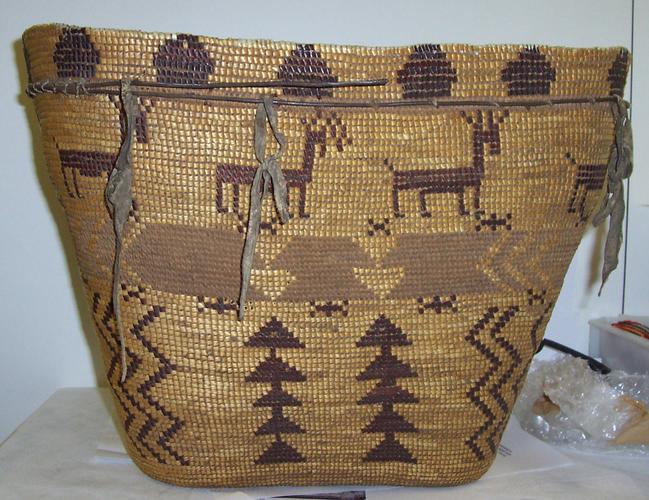-
1 of 253523 objects
Pack basket 1900-19
Bark, grass, quill | 33.0 x 49.0 x 33.0 cm (whole object) | RCIN 74597

Tsilhqot'in First Nation
Pack basket 1900-19
-
Baskets such as this are used by the Tsilhqot'in when travelling from place to place and are lashed to the saddle of their horses. This basket is from the Tsilhqot'in First Nation of British Columbia who are a Dene or Athabaskan speaking people.
The foundation of this basket is made of split roots of the spruce tree made into a long coil which is bound together by stitches also of fine spruce roots. The ornamentation is wholly on the outer surface and is generally known as the 'imbricated' form. This style is only found in a limited area, ranging from the Chilcotin country in British Columbia to the Columbia River in the State of Washington. The light ground-work is formed from the split stems of a wild grass and the brown figures are made of strips of the bark of the wild cherry tree; the principal figures are of caribou and arrow points.
The upper edge is wrapped with split quills of the wild goose and a little below it is a strengthening rib of wire, a vast quantity of which was taken by the Chilcotin district more than one hundred years ago when it was proposed to connect the American continent with Europe by a trans-Siberian telegraph line. This line was suddenly abandoned when the transatlantic cable proved a success.
Provenance
Made by the Tsilhqot'in First Nation; collected in 1919 by CF Newcombe. Basket then presented to the Prince of Wales (later Edward VIII) by the Government of British Columbia, 1919
-
Medium and techniques
Bark, grass, quill
Measurements
33.0 x 49.0 x 33.0 cm (whole object)
Category
Object type(s)
Place of Production
British Columbia [Canada]